Dear Friends, The shamanic path predicates one to Listen: listening allows us to perceive the world around and within us. Synthesia is the process whereby all our senses work together to interpret and respond to our experiences. Whether through touch, light, smell, taste, or hearing, some combination is employed to allow us a profound understanding of whatever we are encountering.
Sound is the most frequent triggering of this synthesia process. If one of our senses is underdeveloped, various shamanic methods exist for improving in this area. That's because we rely on our senses for thriving spiritually as well as for sheer survival! We rely on them when doing shamanic healing. Whether in our daily living or in
special occasions (e.g. ceremony and healing), our sensing bodies are the source for Knowing and Doing. So it is not surprising that shamanic traditions have practices during which the apprentice seeks more sensory acuity or learns how to restore some sense that has become diminished through lack of use or is underdeveloped.
One method employed for attuning all our senses, and maturing our Soul, is the practice of Silence. Every spiritual tradition teaches its practitioners to set aside times for walking with Silence. Some traditions provide special times and places for this practice, eg. silent retreats, a weekly day of silence, or the vision quest. The goal of all methods is the same: be Silent and know Spirit (or know the One that goes by many names).
Be Silent so you can Listen.
Of all shamanic practices,
those that focus on leaning how to Listen are considered the most essential to learn. Listening is our shared universality with all other Beings and with the Web both holding and weaving All-in-One. In one Northwestern tribe, shamans would send their apprentice alone to the wilderness with a singular goal: "Go learn from the Animal how it listens. Come back and demonstrate you have so learned." The student's task was to track, follow, observe, and see how the particular Animal Listened to its surroundings. Of course no one could completely know just how a specific animal listens nor would humans be able to duplicate the individual Powers of Listening. Nevertheless certain skills were acquired and countless ancestral lore is derived from these times of Listening to an animal listening.
Once we start consciously cultivating the practice of Listening, it almost becomes impossible not to listen and then comes the next step: how to receive what one hears and
how to respond appropriately---if response is needed.
 Seuketat is an Eskimo word for this deep Listening and translated means: "the ear of the animal." I have come to more fully appreciate this phrase through my years of studying and observing Bear. But my appreciation did not take complete rooting in me until I practiced over a long period of time how to move as Bear, for it became clear that Bear is ALWAYS Listening and Bear's Third Ear seems located somewhere just slightly back of the head, between the two ears, and deep in the skull. I now think I actually can see Bear listening with that Third Ear on those rare occasions I see Bear in Bear's wilderness habitat. So what does it mean for each of us to practice or to move with "the ear of the animal?" Seuketat is an Eskimo word for this deep Listening and translated means: "the ear of the animal." I have come to more fully appreciate this phrase through my years of studying and observing Bear. But my appreciation did not take complete rooting in me until I practiced over a long period of time how to move as Bear, for it became clear that Bear is ALWAYS Listening and Bear's Third Ear seems located somewhere just slightly back of the head, between the two ears, and deep in the skull. I now think I actually can see Bear listening with that Third Ear on those rare occasions I see Bear in Bear's wilderness habitat. So what does it mean for each of us to practice or to move with "the ear of the animal?"
Certainly this entails some focused times of Silence without and within. The Silence without - or silence in
one's immediate surroundings - is to promote finding and learning Silence within. Once we experience Silence within ourselves, we begin creating a navigational map instructing us how to return here and how to bring Silence here to Silence there. By weaving the Practice of Silence with the Art of Listening, we develop the Ear of the Animal or the Shamanic Third Ear.
Be Silent so you can Listen to what you are Hearing.
Be Silent so the Whisperings from the Mysterium can find you.
Walk with Silence so you can hear other Beings within the Earth Community
and thereby learn more of your place and your role.
Different experiences these last two weeks have led me to reflect on Silence, Sound, and Listening & their significance in the practice of shamanism. They are a good beginning place for this month's reflections.
The Loudness of Home
One morning Bob and I were setting up our space within which to drum and tune ourselves to the day now awakening. While lighting the candle, I became aware of this seemingly loud roaring in my ears. "It is just too noisy in our living room," I thought. I moved to the refrigerator and pulled its plug... listened again... ("still too noisy")... I moved to the far wall and turned off our heating system.
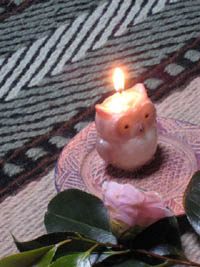 'Blessed, blessed quiet' was my body's response as my shoulders relaxed, my chest expanded, and I could hear the birds singing in the garden. Now could I hear our drums, and experience my harmony with the world beyond my skin. We've been doing this daily practice for
eight weeks now. This is the first time, however, that I felt held within my home space rather than my usual contending with loud, disconcerting sounds. 'Blessed, blessed quiet' was my body's response as my shoulders relaxed, my chest expanded, and I could hear the birds singing in the garden. Now could I hear our drums, and experience my harmony with the world beyond my skin. We've been doing this daily practice for
eight weeks now. This is the first time, however, that I felt held within my home space rather than my usual contending with loud, disconcerting sounds.
I journeyed to inquire about the 'optimal ambience' within which to do our daily shamanic practice. Issues of Silence, Containment, and Simplicity were presented to me as important; one Teacher instructed me to focus specifically on Silence and its importance on the shamanic path.
I noted with interest that at noon on this very day, I had an appointment with an audiologist here in Santa Cruz. In December a routine hearing test prompted her to recommend I purchase a hearing aid for my right ear. She then checked my health insurance to see what portion of the cost would be covered. The results: because I was not in the danger zone of losing so-called "necessary hearing," no coverage was available. This decision is based solely on speech and "urban emergency frequency sounds" (e.g. ambulance, the beeps
at street crossing lights, etc.) Of course, no decision considers the sounds one might wish to hear within the natural world around us. Three fourths of the time I can follow conversations although often the struggle to hear is quite tiring and stressful. So I postponed making a decision to purchase one until such time as I felt it necessary.
In the last two months, I have been preparing for shamanic gatherings in which there might be intense and lively conversation within the groups. My desire to track these conversations and to hear the Sounds of the natural environments in which we would be gathering led me to acquire a hearing aid. Like my other shamanic tools, it would assist my walk and work in the world.
Loss of Hearing - Listening within Circle
For the last eight to
nine years, I have had no hearing in my left ear. One morning I woke unable to hear on the left side. Diagnosis revealed that a major nerve had been irreparably damaged - just how or why this occurred is unknown. Subsequent trips to specialists left me aware it was unlikely I would ever recover hearing in this ear. Overnight I had become someone who could only hear from one ear; at first I was staggered by the change.
There is a profound difference between monotone and stereosound... and it becomes more significant when some hearing loss has already occurred in the other ear upon which one is now completely dependent. The first few years after my left-ear hearing loss, I was quite conscious of adapting myself so that, like a satellite dish, I could turn my head in various directions to scoop up the sounds. If I forgot to do this, often I was unaware someone on my left side was speaking and I certainly couldn't hear anyone approaching from that side. More
important, however, I was committed to ensuring that the Sound environments through which I moved were not ones that would further damage my one remaining hearing ear.
Like many others with hearing challenges, I struggled to follow the flow of conversations in groups and especially in workshops or Circles I was leading. I became acutely aware how some people speak very softly, others quite rapidly, and some rather loudly.
Since so much of group work is based on listening and hearing, I had to develop ways to try and ensure that I could track conversations in Circle. This was most problematic when picking up conversations of those sitting to the left of me since I might not even be aware they wished to speak and/or were speaking. I learned some very interesting things about Circle dynamics and Circle communications. That topic is for another newsletter! Right now I want to focus on the challenges of hearing in Circle.
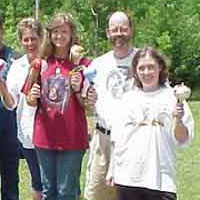 One intervention I discovered worked well was asking people to shake a rattle when they wished to speak. This functions similar to a 'Talking Stick' that is used in some Circles. However, unlike a Talking Stick, I can hear clearly the sound of the rattle and thus turn my head in the direction of the speaker. It was also marvelous to see how this one intervention, born of necessity, actually became a form of honoring both speaker and listeners. One intervention I discovered worked well was asking people to shake a rattle when they wished to speak. This functions similar to a 'Talking Stick' that is used in some Circles. However, unlike a Talking Stick, I can hear clearly the sound of the rattle and thus turn my head in the direction of the speaker. It was also marvelous to see how this one intervention, born of necessity, actually became a form of honoring both speaker and listeners.
Rattle says: "I wish to speak myself - and I wish your attention while so doing."
Shaking one's rattle replaces, too, the raising of hands. I have always thought that the raising of hands simulated our early school environments in which we are asking 'permission to speak?' from the teacher. In a Circle such permission is given, not by the leader, but from the Circle itself.
When someone shakes their rattle, like a
witnessing nod, everyone in Circle turns and attends. And in some mysterious way, even the spirits seem to answer the call and surround the one speaking. In addition, rattles have the ability to stir the air or fire both within and around one's self; rattles stir the imagination too. If this is done with intention and attention, then speaking one's self become a Circle sacrament.
Even with our attention turned to the speaker, there is also the matter of being able to hear what is spoken. For the longest time I assumed everyone else could hear each other and it was just my problem if I could not. I didn't let that deter me from asking someone to repeat or to raise their voice, because I had committed my self to Listening to each person. Sometimes, however, I became quite tired by the end of a day by the challenges of Listening so hard and sometimes still not hearing.
One evening I was listening to someone share her journey. I could see her lips moving
but simply could not hear what she was saying. I told her I could not hear her and asked if she would speak louder - I assumed she then raised her voice and yet I still could not hear but the slightest sound of words being strung together.
Was I losing completely the hearing in my right ear?
I glanced around the Circle and everyone was looking at her so I assumed they could hear her. At that point, I didn't say anything else, watched her lips, and tried to see if I could pick up some idea of what she was sharing - with little luck. Imagine then my surprise when later I share with another woman my concern about this and she tells me she couldn't hear either! Regrouping after a short session break, I share my experience and each one gives feedback. The result: the majority of the women could not hear her. The few who 'thought' they knew what she was saying were sitting close to her!
I
wondered aloud "Why didn't anyone say they couldn't hear." The responses ranged from "I was taught it was rude to interrupt someone speaking... " to "I was waiting for you to say something"... to "I had just spaced out and wasn't paying attention."
There is something quite humorous about this were the results not so unsettling. Now when I'm doing Circles, I start by simply sharing the following: the loss of hearing in my left ear-and why I may ask someone to raise their voice; using the Rattle to let the Circle know one wishes to speak or share; raising one's hand when one cannot hear the speaker; and attending those who are speaking.
I have also learned to take more frequent breaks when there is extensive verbal sharing in a Circle. To truly Listen and to Hear requires us to be Present to the particular person speaking. If we are also
processing what we are hearing, then we are working our senses, our bodies. Most of us are not accustomed to long periods of this way of being Present so we need to take breaks, stretch our bodies, and then return to the most comfortable position for Listening and Hearing. We need to do this before we hear that restless stirring in a Circle that indicates folks are tiring and need to switch gears - even if only momentarily.
Being heard and being seen are primary needs and these needs can only be filled when I have committed myself to listening and seeing (others) and to speaking my Self. A major blessing of the Circling Way is that we can do this for one another and take this Way into all our relations.
The Sound Environment of Shamanic Circles -
The Power of Drums & Rattles
When I first lost my left-side hearing eight years ago, I saw a specialist at the University of California Medical School in San Francisco. He wanted to make sure that I understood what specific sounds and the level of other sounds would damage, or at least compromise, the remaining hearing I had in my right ear. In his sound studio he wanted to create the typical sound environments in which I do my work so I took along some rattles and two drums that I use frequently, if not daily. In the course of our conversations, he inquired how often am I in such drumming environments, how hard do I play my drum, and how many drums might be played at the same time. We did different sessions in which I varied both rapidity and volume of drumming. Each of these recordings were representative of a typical five day workshop.
He showed me a chart demonstrating
various sound levels in a normal urban environment and compared these with my drumming he had recorded.
He addressed a question I had: "Why do certain sounds hurt so much that they can make me wince and instinctively cover my ears."
Part of the damage done in hearing loss affects the ear's ability to dampen down sounds; the consequence of this is that high frequency sounds are experienced at decibels higher than the normal hearing person would experience. That's why certain frequencies such as those emitted from televisions, whistles, or even from rattles, filled with particular materials, are experienced as painful to the ear.
Knowing how these sounds might be experienced has really changed my life and how I do certain shamanic activities - for example, I never shake a rattle vigorously around someone's head or drum too close to someone's ears. In the rare instances that I forget, I have trained myself to automatically respond to the
nonverbal cues, from the other, that indicate 'this is uncomfortable' or 'that hurts' and I immediately stop. These changes haven't made me any less spontaneous or any less vigorous in my shamanic activities. Actually knowing these cues, and knowing the effects of certain sounds delivered to our ear, allows me to be more vigorous, more spontaneous because I KNOW I am not hurting the other in those ways about which I learned. Clearly the more we can learn and understand about Sound and our experience of Sound, the more effective we can be.
The last thing the audiologist did was to record my playing of Drum at a sound volume that was safe. I played my Drum long enough so I knew how that volume felt in my body and sounded to my right ear. Thus I had embodied Knowing of the wide range of drumming that was safe. I knew the range within which damage can, and most often does, occur. As a final cautionary note, he informed me that any time I felt tinnitus
(ringing) in my ears, that meant the hairs that aid hearing were being damaged and to definitely avoid such environments. Of course, we both realize that we walk through a loud, frenetic and sometimes shrieking world of chaotic sounds. Some of this cannot be avoided but I could exert more control over how long I might be subject to such sounds. Our main concern was to make sure I was not doing work that would result in complete hearing loss.
These audiology sessions occurred during Winter - a time when I am usually not teaching workshops and I stay home to hibernate as much as possible with the DreamingWorld. So I had plenty of time to develop a new relationship with my two primary drums. I had time to find the rattles that were strong in spirit but had good sounds. I imagine there's a time and place for all the other different voices of our shamanic tools. But I had a specific intention in my tool-choosing: to use Drums and Rattles for
shamanic purposes that would not, when played, damage my hearing in my left ear or be painful to someone. Above all, these tools are for bonding with Spirit and for healing.
When I resumed teaching, I began introducing how to work more consciously with our Drums. Early workshop sessions included learning more about Drum's physical form as well as spiritual qualities. I noted occasions in which Drums seem to be 'beaten' and those in which the Drums were evoked or listened to as living Beings. I started inviting participants to join in keeping a harmony with our drumming by everyone using the same sound volume.
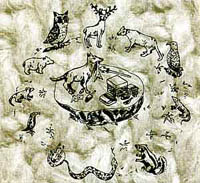 I understood how drumming in harmony creates this round container that has an even rim; a container into which any of us can fall or dive without losing our balance due to a topsy-turvy boat.
The Rim of the Circle is not only horizontal but vertical, too, and Spirits can slide down this verticality and land in the very center of our Circle. This type of Circle drumming is different from the times I may be dancing or doing healing. I'm talking about the drumming we do frequently in our Circle to call us and Spirits to Circle. I understood how drumming in harmony creates this round container that has an even rim; a container into which any of us can fall or dive without losing our balance due to a topsy-turvy boat.
The Rim of the Circle is not only horizontal but vertical, too, and Spirits can slide down this verticality and land in the very center of our Circle. This type of Circle drumming is different from the times I may be dancing or doing healing. I'm talking about the drumming we do frequently in our Circle to call us and Spirits to Circle.
I became especially concerned to use our drums to send us deeper into our bodies and not so loud as to drive us out of our bodies. I mused upon the fact that our ancestors often used their drums outdoors or indoors within structures that were permeable and not trapping of sound. A fair amount of contemporary drumming in circles occurs within environments where sound cannot move beyond the skin of the walls and
thus, has the potential to simply implode us. And now, for my own protection, if I'm in a situation where the drumming is so loud that my ear hurts, I simply withdraw from that space and re-enter when the group is through drumming.
And perhaps of most significance to me: I began exploring the issue of transcendence and incendence. Altered consciousness, as sometimes referred to in shamanic training, can indicate leaving our bodies, transcending the Earthly realms, rising up and above the material world. Incendence indicates, in part, descending more into or bodies and in the very, very center of our Selves finding the threads that link us to the Eternal. In those times of incendence, I am transcending the threads that bind me to ONLY the material forms or the personal internal luggage that I drag through my living - the luggage that drags
me too! But I am not transcending my self---I am not leaving the core of who I am... I am experiencing that Core of My Self in its Divinity, in its Holiness.
I am still exploring this issue and searching for more conscious ways of practicing shamanic incendence. In that respect I am grateful for the hearing loss that prompted my change in both tending and attending.
Having a Sound Relationship with our Drums
I've no idea how useful my experience might be for others of you but I do think the issue of coming-to-Drum and being-with-Drum is important. And I do have concern that some of us may be jeopardizing the health of our hearing... maybe not in the very moment... but for the years coming. This is analogous to sports' injuries that may not prevent playing the sport in the present moment but may lead to a real reduction in overall health down the
road.
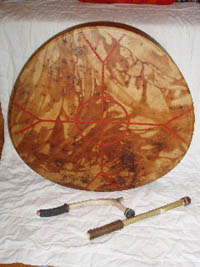 Equally important is our ongoing relationship with this other Being whom we have named Drum. As with any relationship we wish to cultivate and seek some enduring friendship, we need to know our welcome and to welcome the other. When coming to meet another person, do we collapse the distance before we are even seen? Do we note how the other person seems to be and make our responses accordingly? I'm persuaded now that the quality of my shamanic experiences is relational to the quality of my relationship with Drum. Drum is my shamanic walkabout partner. When we meet and engage, does Drum know my affection for Drum? Do we have time for greeting and being greeted? Sometimes this greeting is in my eyes; sometimes through gently touching Drum's face and registering the temperature of Drum's skin. In that moment I offer Drum my open receptive palm, my hands, and listen to
note if Drum needs some tending before we begin playing together. Equally important is our ongoing relationship with this other Being whom we have named Drum. As with any relationship we wish to cultivate and seek some enduring friendship, we need to know our welcome and to welcome the other. When coming to meet another person, do we collapse the distance before we are even seen? Do we note how the other person seems to be and make our responses accordingly? I'm persuaded now that the quality of my shamanic experiences is relational to the quality of my relationship with Drum. Drum is my shamanic walkabout partner. When we meet and engage, does Drum know my affection for Drum? Do we have time for greeting and being greeted? Sometimes this greeting is in my eyes; sometimes through gently touching Drum's face and registering the temperature of Drum's skin. In that moment I offer Drum my open receptive palm, my hands, and listen to
note if Drum needs some tending before we begin playing together.
Just imagine being stuffed away in a sleeping bag, pulled out, and with no further ado, being required to sing your soul's song on the spot or having your 'sweet spot' beat upon before your sweetness in total is acknowledged. To add further insult, without time to find your balance and wakeful self, you are required to immediately be handled and rapped upon with no attention given to wiping the dusty sleep particles from your eyes. I use these analogies because they are a way to indicate my perception of Drum as a living, breathing, entity... usually gifted to me through sacrifice of some Animal and Tree.
So let us play with our Drums in the manner of all Sacred Play. Let us find ways to introduce our Drums to other friends and possible shamanic playmates. For example, often now when a Circle first gathers, I invite the Drums to be introduced and joined with us in Circling. That means
one drum is played... then the next drum (while the first one quietens)... then the next Drum... until we have gone around the whole Circle and each Drum has been seen and heard! And altogether the Drums and the Humans have acknowledged... have seen and listened... to the presence of each other.
This can be wonderful... simply wonderful. It is a wonder-filled way to acknowledge these Beings and honor their individuality. And as the Drums continue to introduce themselves, one by one, a deep belly awareness starts developing as they gather increasingly there Many-yet-One Power until we are all dwelling with, playing with, and holding together the Great Grand Round One called DRUM.
The Practice of Silence within the Home
I have a vague memory or practicing Silence within our home. Years ago I included a
certain morning of Silence during the rhythm of each week. I wonder why I've not thought to do that these last many years. I shall do this again. For me, this requires setting aside some room or space in which I can also control my Sound environment. It requires my Silence be honored since there are times of encountering others - esp. when I move from house to the Land. I cherish being Silent within the Land for this is how I can Listen to the unfolding drama called Nature.
My birthday is in June and I've decided to gift myself with a day in the week for re-treating into Silence. At first, I may find that only part of a day or one day of the month will allow for easier integrating of this practice into our life together. This integration is important: setting aside times for Silence in any shared space, requires some support from others. Different choices may exist: perhaps there is a room that can be used for Silence practice. If not a room, then arrange
with your partner or housemates for a time period absent conversation, television, computers, phones, or any other forms of engagement that may take your attention away from yourself and places a higher priority on attention to others.
As with any change in established interpersonal patterns, it's important that I realize this practice will impact the other. Since Silence is requested, this requires others to withhold conversation from you. But there is a critical difference in re-treating to within one's self and turning away from another. Turning away can be experienced as rejection while retreating can be experienced as the opportunity to support the partner seeking Silence.
And now it occurs to me that I can raise this issue of self-retreating with my Drum Circles. We could journey and learn from our Ancestors about their practices of Silence. There might be others
in the Circles who wish to do this practice. Together we can explore, cultivate, and receive support for infusing our homes with the joys and treasures of walking this path.
If we don't manage to have time in-and-with Silence, how shall we hear that soft Voice of Spirit. How shall we re-turn our selves to Center when we are dispersed by our busy and loud lives. Silently holding hands when we arrive to Circle becomes that moment when our breathing and Spirit's breath are One and we start our re-turning to Self as well as Circle.
Silence is the Sound of Spirit breathing the Universe into Being.
In Closing
I close with a reminder about the SSP June Conference here in Santa Cruz County. For those not knowing, the focus of this gathering is "Self in Service: the practice of Shamanism without
Borders. The SSP website provides clear information regarding the weekend and includes the way to register.
As of April 28th, there are only 14 spaces available so, if you are interested, I urge you to register. The conference is focused on how we might work together, as an international shamanic community, to tend Places that have experienced trauma from the impact of Earth events (e.g. Earthquakes, flooding, hurricances). Together we will go to sites in Santa Cruz County that still bear the inprint of such traumas. What is learned together this weekend includes shamanic ways of tending that are applicable, in some manner, to other regions of the world including one's own community, one's own backyard.
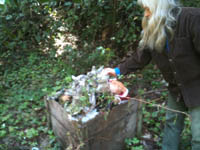 Issues of
ethics, appropriate tending and healing methods, collaborating with others in such sites, and developing a cohesive response to these traumatic events are some of the primary topics. Our world will probably experience more and more traumatic Earth events because Earth herself and her various forms (river, mountain, desert) are changing rapidly. This is our opportunity, as Walkers of this Path, to work together, to collaborate with our Spirits and Helpers. Issues of
ethics, appropriate tending and healing methods, collaborating with others in such sites, and developing a cohesive response to these traumatic events are some of the primary topics. Our world will probably experience more and more traumatic Earth events because Earth herself and her various forms (river, mountain, desert) are changing rapidly. This is our opportunity, as Walkers of this Path, to work together, to collaborate with our Spirits and Helpers.
This is a gathering where we will be doing what shamanic practitioners do best: in Circle, working with Spirit and our many Helpers to understand, to divine, to tend Earth and her inhabitants with the intention of leaving footprints of harmony and some peace within the Land.
Working together, we can tap into our individual and community resources, call upon the Spirits that work with us, and participate in the changes being asked of us... being required of us... to tend Earth in this time of
historical urgency. This SSP Conference is but one example of the shamanic community saying: "let's make a difference born of love, educated minds, strong hearts," and a difference that demonstrates we have Listened and we are Responding.
I wish for each of us Silence
Opportunities taken to grow the Ear of the Animal
To use the Shaman's Third Ear
Listen... listening... listen
Hearing the Voice of Spirit... always near, always here..
Love and blessings,
Carol Proudfoot-Edgar
Please make note that my email address has changed. I no longer can received email at my old AOL address.
My new address is:
carolproudfoot@shamanicvisions.com
We now have audio versions of these newsletters, read by Susan Gilliland, available on the Shamanic Circles web site.
Note regarding future workshops:
My 2010 Calendar of Workshops can be found at my website. The Calendar is under periodic revision so I invite you to check there late Spring and mid-Summer for any workshops added or changed since January. The website includes other shamanic resources.
**Except for the SSP Annual Conference (June), these workshops are limited in enrollment. Other than the May Women Healers Retreat, all these workshops are for men and women (referred to
as Mixed Group). There has been some confusion about this because for several years I was teaching many Women's Circles and some people presumed my workshops were for Women only. I have always felt it is our working together, men and women, that will lead to a transformed world.
Susan Gilliland and I continue to teach together. In addition to working with Susan and Pirkko, plans are underway to teach another workshop (at an animal shelter) with Dan Jordinelli in Los Angeles in mid-Summer.
If you wish more information or to be on a workshop mailing list, please contact the coordinator
Pirkko Miller at pirkko@embarqmail.com. Registration is also available at my website: www.shamanicvisions.com
Carol's Workshop Calendar for 2010
May 7 - 9
Women Healer's Retreat - Santa Cruz, CA (Fri - Sunday)
June 3 - 6
Society for Shamanic Practitioners (SSP) Annual Conference "Self in Service: Shamanism without Borders" Soquel/Santa Cruz County, CA - for information & enrollment: www.shamansociety.org July
18 - 23
Bridging East and West: Bear Roams the World
This is a workshop I will teach with Hideki Hamada (Japan) and Cheryl Ban. The workshop will focus on Shamanism and BearMedicine. This Supreme Wilderness Physician is the Tutelary Spirit for both Western and Eastern shamanic peoples. A more complete description of this workshop will be posted at the end of April.
July 29 - August 1
Philadelphia, PA
Sept. 9 - 12
Spirits of Place and Creation of One's Medicine Bundle.
Mixed Group - Santa Cruz, CA (Thursday - Sunday)
Every shamanic practitioner is advised to create a Medicine Bundle. The primary issues are: what is held within the Bundle; how is the Medicine
Bundle used, renewed, and named. Items within a Medicine Bundles are primarily received from Nature and certain Tutelary Spirits within Place. During this weekend we will create our individual Medicine Bundles, empower it, and use it in various healing activities.
More Information |



